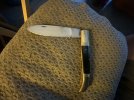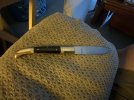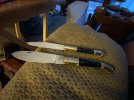5K Qs
Gold Member
- Joined
- Jul 20, 2014
- Messages
- 15,275
The BladeForums.com 2024 Traditional Knife is ready to order! See this thread for details:
https://www.bladeforums.com/threads/bladeforums-2024-traditional-knife.2003187/
Price is $300 $250 ea (shipped within CONUS). If you live outside the US, I will contact you after your order for extra shipping charges.
Order here: https://www.bladeforums.com/help/2024-traditional/ - Order as many as you like, we have plenty.
decided to try this style from India with a carbon blade, got two, this on has a few issues.

I wish MAM still made 'em like that.
But is it "thrifty" to buy the car (450SEL? 600?) to get the knife for "free"?
.4 lb? What is that, about 6 1/2 oz? That is heavy for a pocket knife! Neat knife.Recently-acquired Marbles all-stainless rigger knife is 4.25" closed and weighs in at a massive 0.4 pounds. Marlinspike does not lock.
(The photo would be really cool if it showed the Marbles knife on a chunk of marble, but the rock in the pic is just some run-of-the-mill veined stone.)
View attachment 1882898
- GT
Terrific old toothpick!Hammer Brand Toothpick


Vince, the 0.4 lb is in the vendor's description on the website, and that would be about 6.5 oz. That seemed very heavy to me, too, since I thought my heaviest knives were "quarter-pounders". But I just pulled out an ancient scale we have on a top shelf of a kitchen cupboard, and it puts the knife at about 200 g = 7 oz. Definitely heavy metal..4 lb? What is that, about 6 1/2 oz? That is heavy for a pocket knife! Neat knife.
7 ounce for a Marlin Spike/Rigger's Knife sounds about right. That marlin spike isn't hollow, after all.Terrific old toothpick!
Vince, the 0.4 lb is in the vendor's description on the website, and that would be about 6.5 oz. That seemed very heavy to me, too, since I thought my heaviest knives were "quarter-pounders". But I just pulled out an ancient scale we have on a top shelf of a kitchen cupboard, and it puts the knife at about 200 g = 7 oz. Definitely heavy metal.
- GT
Thanks for the interesting info concerning matters about which I'm totally clueless!7 ounce for a Marlin Spike/Rigger's Knife sounds about right. That marlin spike isn't hollow, after all.
They could make the spike out of aluminum to save a couple ounces. However, in a saltwater enviornment, aluminum corrodes rather rapidly, even if hard anodized.
All aluminum in marine applications (hull, masts/booms, spreaders, out-drives, etc.) are painted. (in wet applications below the waterline, Zink sacrificial diodes are used to help slow the aluminum corroding)
I can tell you from experience that even when painted, aluminum masts, booms, and spreaders get spots of corrosion under the paint, including the factory applied baked on paint.
A Ti spike would weigh a little less than steel, but would add significantly to the cost.
Since most crew I knew carry their rigger's knife (which they purchase, it isn't ship's issue ... at least not in the Caribbean Vacation rental fleet) on their belt or clipped to a belt loop and connected to a long lanyard (several crew I knew on other vessels used a retractable 34~38 inch keys/ID lanyard), weight really isn't much of an issue. You don't notice it on your belt or clipped to a belt loop.


I had a similar knife which I purchased in Seward, Alaska in 1986 if I recall the year correctly. I think it was probably made in Japan. I used it to splice a few ropes over the next several months, then after that it sat in a drawer for many years. At some point I took it out to use the marlin spike as a punch, and damaged the tip (only designed for rope, I guess). After that it languished in a toolbox for a while. It ended its ignominious time in my possession when the toolbox was stolen out of my shed, I suspect by a certain neighborhood ne’er-do-well but I have no proof.Recently-acquired Marbles all-stainless rigger knife is 4.25" closed and weighs in at a massive 0.4 pounds. Marlinspike does not lock.
(The photo would be really cool if it showed the Marbles knife on a chunk of marble, but the rock in the pic is just some run-of-the-mill veined stone.)
View attachment 1882898
- GT
Interesting story.I had a similar knife which I purchased in Seward, Alaska in 1986 if I recall the year correctly. I think it was probably made in Japan. I used it to splice a few ropes over the next several months, then after that it sat in a drawer for many years. At some point I took it out to use the marlin spike as a punch, and damaged the tip (only designed for rope, I guess). After that it languished in a toolbox for a while. It ended its ignominious time in my possession when the toolbox was stolen out of my shed, I suspect by a certain neighborhood ne’er-do-well but I have no proof.

 I've had a knife with a marlinspike readily accessible for almost a year now, mainly to help untie knots. I have no idea how to splice ropes, but I've been trying to teach myself a bunch of traditional knots (bends, hitches, loops, etc.), mostly using about 4' of boot lace I keep in my pocket. When I tie a knot and give it a "stress test" that really jams it up, the marlinspike is quite amazing as a tool to help get the jammed knot untied. (And all 3 knives I've had so far with a marlinspike have also had a large sheepsfoot blade, which is a blade I enjoy using.)
I've had a knife with a marlinspike readily accessible for almost a year now, mainly to help untie knots. I have no idea how to splice ropes, but I've been trying to teach myself a bunch of traditional knots (bends, hitches, loops, etc.), mostly using about 4' of boot lace I keep in my pocket. When I tie a knot and give it a "stress test" that really jams it up, the marlinspike is quite amazing as a tool to help get the jammed knot untied. (And all 3 knives I've had so far with a marlinspike have also had a large sheepsfoot blade, which is a blade I enjoy using.)So, finally sent the smaller knife back and finally got the Soldier’s knife, quite a bit larger, stout and carbon steel blade too. It is what it is, needs sharpening but it has a good snap and decent fit and finish. Can’t beat the price for trying it.So when I am able, I am sending the the one with the issues back to the vendor and they are sending me the larger soldier’s knife with a 4.5 inch blade, I will show pics of it. I will give the other gentleman’s knife to a friend who is a reenactor



Agreed, that is where I got the thought from, a video about what a typical RevWar soldier would carry in his haversack. Even if made in India, all the materials are the same as what would have been available at that time. How stringent are the rules for re-enactors or for living history shows? I ask because I am still going to give the smaller gentleman’s knife to my friend who plays a Civil War chaplin from the Christian Commission. Here are the two together.A worthy addition to a haversack.

I used to do CW reenactments back in the late 80's.Agreed, that is where I got the thought from, a video about what a typical RevWar soldier would carry in his haversack. Even if made in India, all the materials are the same as what would have been available at that time. How stringent are the rules for re-enactors or for living history shows? I ask because I am still going to give the smaller gentleman’s knife to my friend who plays a Civil War chaplin from the Christian Commission. Here are the two together.View attachment 1886905
I used to do CW reenactments back in the late 80's.
Back then, it depended on the group. Some were "thread counters", they didn't like clothing that was sewn on a machine (stitches were too even, and the "wrong" number of stitches per inch, or the weave of the cloth was "too modern" as in "That weave wasn't used before 1870 ...) and other details that were "incorrect" for the 1860 to 1865 time period, that the audience didn't know, nor care about.
I was at one large event in Illinois. One of the people involved in putting on the event tried to run a guy off because he had a Remington Zouave rifle, which the guy claimed "was never issued or used during the war!" The guy with that rifle was part of a New York unit. He showed the ... "know it all fool" at the gate a black n white photo of his 3rd or 4th great grand father, in uniform, taken in 1864, who was a member of the New York unit the guy was portraying. His 3rd or 4th great grandfather (he knew which, I forget) was issued a Zouave. The very one the guy at the gate didn't want on "his" battlefield! (the reenactor's persona at the events he participated in was his ancestor.)
Most times, it didn't matter, as long as it looked like it could have been there. Union was stricter than Confederate, of course - everyone was issued a uniform, arms, leather accessories, etc, so those had to pretty much match. Some leeway was given on arms, since at the time, troops could (and did) buy their own. The side arm in one platoon could be a 1851 Colt Navy or or an 1860 Colt Army or Navy (difference between the Navy and Army was caliber. Navy a ".36" (cylinder was .38) Army was a ".44" (cylinder around .454 to .458) or an 1858 Remington "New Army" or the smaller Navy version. (same caliber as the Colts, but if conicals were used instead of a round ball, there was a significant difference between the Colt and Remington conicals. There were several different rifles used, not all the same caliber, ranging from the .44 Henry rim fire (never an issue arm, but enough companies/platoons/individuals bought one, the Union Government did issue the ammo for them., .54 caliber, .577, .58, The Burnside breechloading cartridge fired by a standard musket cap that was external from the cartridge, the Maynerd cap roll, (identical to what the cap gun of your youth used) To say the quartermasters had a difficult time would be an understatement.
Confederates were not issued anywhere near the amount of gear the Union issued. A lot of Confederates were never even issued a gun! They used what they brought with them from home. (hence my .45 caliber "Kentucky Rifle" was "historically accurate" for a Confederate troop. (I couldn't afford to be Union, cost several thousands of dollars to be Union. only Hundreds to be Confederate.) Confederate uniforms coul be regulation gray ot butterscotch, ora combination of the two. Leather accessories didn't have to match everyone else's in the group, and if you didn't have a cartridge box and/or cap pouch you were not given grief.
I never heard of a reenactor (aside from Buck Skinners) catching flack about their cutlery.
